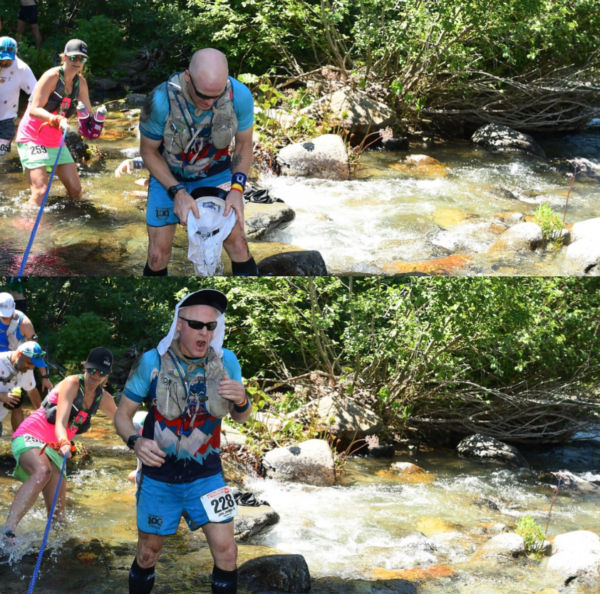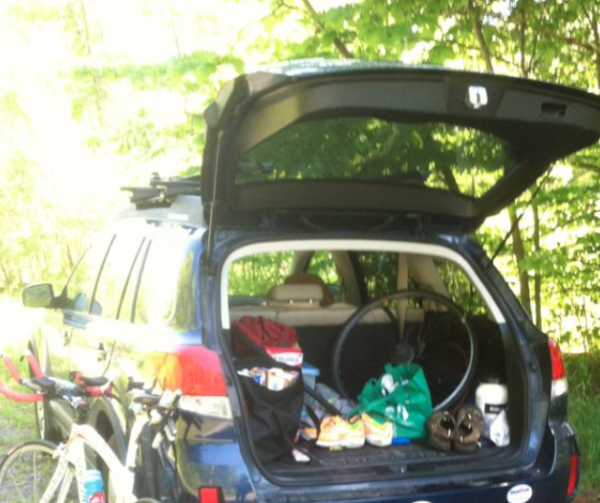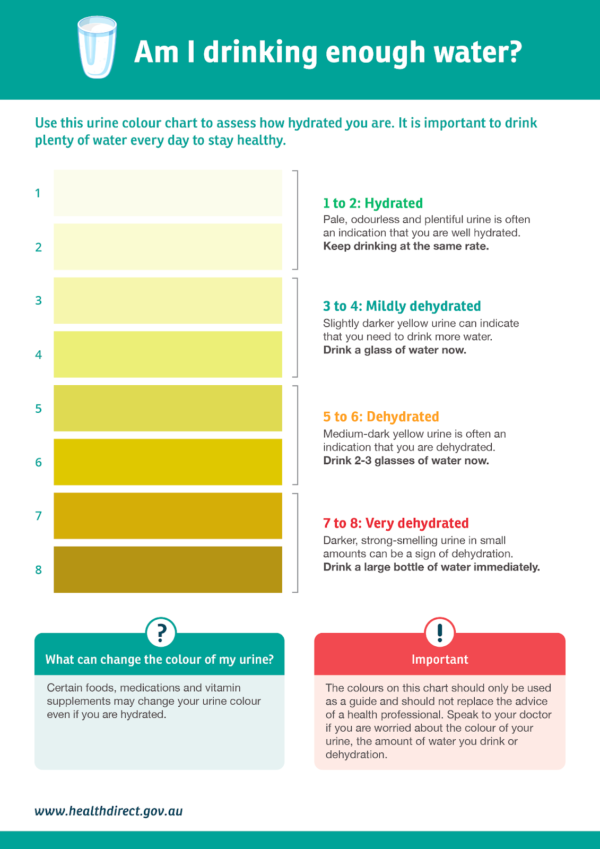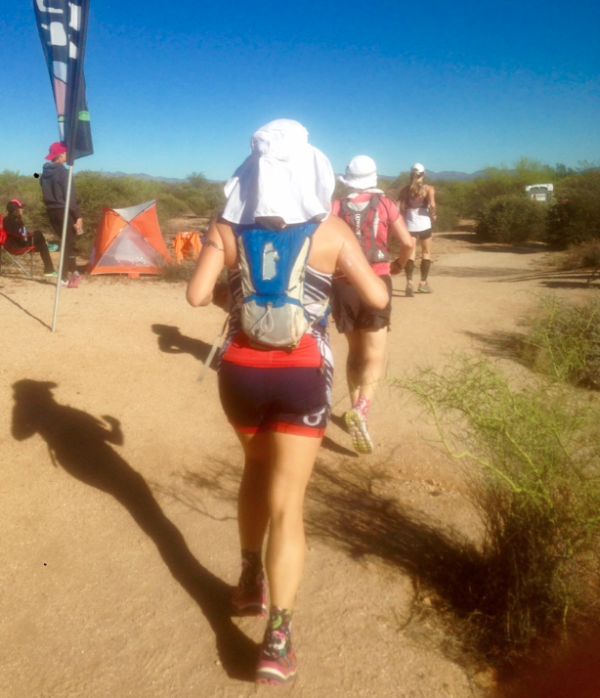Tips to Manage Hot Training Days
I’ll be brutally honest: you can’t beat the heat. It will have an impact on our watts, pace, and RPE, when compared to more temperate conditions.
But, you absolutely can manage the effects of heat and humidity. In this post, we share our yearly reminders to prepare and maximize your chances of success in the heat.

Above: John Jenkins, my husband, working to stay cool at the Western States 100, in 2017. It was one of the hotter years on record for that race.
What Happens to Us in Heat
Most human bodies will perform optimally when temperatures are in the 50s. Increases of temperatures into the 70s, 80s, 90s or beyond impacts how fast we can swim or run and how many watts we can push on the bike. Of course, dew point and humidity can further impact our performance.
Some studies estimate that heat and humidity can result in a run slow down of 20 or more seconds per mile (for the same effort or HR cost), and between 6-10% drop in watts on the bike (again, for the same HR cost). These studies are generally looking at ranges of temps from 70 to 90 degrees, and variable humidity.
The simple summary: the higher the temps, dew point and humidity, the harder the body has to work for the same output in terms of pace or watts.
Why is it harder? Our circulatory system is responsible for 1) delivering oxygen to our muscles (as well as everything else in our bodies), and 2) heat regulation. When our core temperature rises (as it does in exercise of any type and in any weather), the circulatory system increases blood flow to our skin, allowing us to sweat. Sweat is our #1 cooling mechanism.
In cooler weather, the circulatory system doesn’t need to work so hard on the cooling aspect. But, when the temps ratchet up, it is faced with a competitive dilemma: oxygen delivery versus cooling. Given this competition for resources, the cardiovascular system has to work harder to keep up – thus the elevated heart rate.
In addition to an elevated heart rate, your sweat rate will increase. This means that you will have different fluid intake needs in 50 degrees versus 80 degrees. Additionally, humidity and dew point will impact sweat loss as well.
Benefits of Heat Training
The heat isn’t all bad! Your body can and will adapt, allowing you to race strong. Some benefits of training in the heat include:
- increased sweat rate – to help the body cool
- increased blood plasma volume (you’ll start sweating sooner and at a greater volume)
- enhanced core temperature regulation
- reductions in blood lactate
- increases in muscle power
- improvements in VO2max (some studies say better than training at altitude due to the increase in red blood cells that happen during heat training)
- improved ability at cooler temperatures (you know those few cooler days we get and you feel like you are shot out of a cannon? Yup – that’s a benefit of heat training!)
- Improved mental fitness for managing the stress brought on by heat
With adaptation and preparation, you CAN manage the heat. Don’t let poor preparation hijack your race dreams. Taking the time to ensure you are prepared for the heat allows you to #1 BE SAFE and #2 get the work done.
How to Manage the Hot Training Days Once They Arrive
1. Always Bring Water
Yes – even for those 15-30 minute frequency runs. I’d rather be looking at it, then looking for it. And, those frequency runs are almost always coupled with something else – so you need hydration for the entire duration of the workout.
Proper hydration isn’t just about your performance on the workout you are doing – it is also about your recovery so you can get back to it the next day.
How much hydration is enough? See this previous article on hydration.
2. Get Loopy

My go-to method to make sure I stay cool and hydrated is to create a loop course. This loop can pass by your home or your car, which becomes your “aid station.”
Make the loop short enough that you can replenish regularly. The length of your loop depends on how much hydration you want to carry as you run; if you run or ride with a hydration vest or have the ability to carry 3 or more bottles on your bike, you can extend the duration of the loop. Don’t go further than your needs!
Even if you wear a hydration vest or have multiple bottles to get you through a workout, being able to grab some ice or a cold rag can feel GREAT!
Your aid station can include:
- A cooler to keep your cold stuff COLD
- Pre-filled bottles (for quick swaps).
- For super hot days, freeze about 1/3 of the bottle the night before and then top off with water right before you use it. This ice block will help to keep the bottle cold throughout your loop.
- Ice – you know how much you love the ice when you race? Why not enjoy it when you train! A clever trick to carry your ice:
- 1) Cut the legs off a pair of panty hose, but leave the toe intact.
- 2) Fill the leg with ice.
- 3) Wrap the leg around your neck, your waist, or both
- If you do this, be mindful, it will make you wet. So, be sure to put anti-chafe lube anywhere there is friction. (Between the legs, under the arm pits, and the bike chamois are must-lube spots. And each of us have our own unique hot spots.) For lube, I recommend TrailToes.
- Cold rags
- Extra cold water to refill your bottles or your hydration vest in the event that you run out of pre-filled bottles.
- If you have more than one hydration vest, you can keep one in the cooler and switch the vests out – it feels SO GOOD when you put on the cold one! (Ultra runners: this is a PRO TIP for your crew to do while you race!)
- Additional calories
- Your woobie (just seeing if you are still with me…)
- Sunscreen – apply when you start, but with sweating, you will likely need to re-apply. Sunburn will only make you feel hotter. And, applying sunscreen can have a cooling effect.
3. Hydration Alternatives
If the idea of doing loops makes you a little crazy, or your training will take you to places where loops won’t work, here are more ideas for you to consider to ensure you get your full hydration needs met in training.
- Wear a hydration vest. These are great not only for holding all your water – but also your calories, phone, money – whatever you need! When you fill your vest, fill it with ice to help keep the water cold for as long as possible. This works for the bike or the run.
- Plan out routes with convenience stores. This works great for long workouts. Just like your cooler, you can use stores to get ice, cold water, and snacks! Don’t forget money.
- For trails, where loops back to the car or convenience stores aren’t an option, get yourself a water filter system. I’m a fan of the Katahdin Be Free flasks. I use them in training frequently, as well as for remote wilderness races.
4. Expose yourself to training in the heat
During the summer, it’s impossible to avoid the heat. But, if you are new to training in the heat, start off by training earlier in the morning – when it is still warm, but not quite yet stifling.
Gradually introduce yourself to training during warmer parts of the day – especially those times when you may be racing. This may mean training into the afternoon on weekends, or in the later afternoon/early evening during the week.
5. Adapt Intensity
On very hot days, you will need to adjust your expectations for pace or watts. You simply won’t go as fast or push as hard for the same energy cost. You also want to be VERY careful how hard you push in extreme heat. Heat stroke is a real thing – trust me, I’ve gotten it.
There are calculators that help you understand the impact of heat on pacing. For example, consider this one from RunnersConnect, which takes into account the dew point and the temperature. However, we recommend that you don’t pre-determine shifts for your pacing or watts.
Rather, use a mix of RPE and heart rate to determine how your body is responding to the heat on any given day. As you become more acclimated, you will likely find an increased ability to go faster or use more power in similar conditions.
Your RPE is likely the BEST guide to how much you can – or should – push effort in the heat. You can couple this with heart rate, which gives you an indication of how your body is responding to an effort on any given day.
For heart rate, you may allow a 5 to 7 beat “bump” when running in very hot/humid weather. Don’t jump right to the top, but if your HR leaks upward in the final part of the run, just let it go – but don’t exceed the top of the next zone. For example, if the workout calls for Z2 – you can leak into Z3 – but not above it! (If you do this, you should note the temperature conditions in your comments for your coach so they understand why you went “above” zone.)
6. Know the signs that indicate you might be heading into danger.
Stop immediately when you experience indicators of heat exhaustion or heat stroke. These include (but are not limited to): dizziness, lightheadedness, cessation of sweating, clammy skin, and mental confusion.
Keep in mind that heat stroke may not come with warnings. For example, when I did the Vermont 100 in 2019, I was fine until I wasn’t. Once it hits – it hits hard. Be smart and see the help of medical professionals if you do get into trouble. But, do your best to make sure you don’t get to this.

Additionally, take note of how often you are peeing. If you aren’t peeing about every 3 hours – you need to increase your fluid intake. Also take note of the color of your pee.
7. Other tips that don’t have a neat category
- In very humid conditions, wipe the sweat off your face and body when it starts to pool up. This will promote more sweating, which will aid with cooling.
- Wear a visor or hat to keep the sun off your face
- Wear training gear with QUALITY material. Lighter colors can keep you cooler. But, if the material is good, it won’t matter.
- After a hot session, make sure to rehydrate and focus on quality recovery. Take in hydration with some electrolytes as well. You don’t need to overdo this. It can be diluted sports drink, or using electrolyte mixes (such as Hammer Fizz or Skratch).
Flip the Script

It’s worth noting that your mental response to how the heat feels is worth working on. Flip the script on the voices that want to be put on repeat: “It’s hot. I feel hot. It’s so hot.” That attention isn’t helping you. It’s wasting energy.
Instead, flip that script to “fool” yourself: “I get energy from the heat.” “I prepared for this.” “I thrive in adversity.”
Similarly, if you tell yourself that you “aren’t good in the heat,” you almost certainly guarantee that will be so.
Instead, put your focus on how you can adapt to the circumstances by keeping yourself as cool as possible, adapting your intensity, and taking all of the steps you can to set yourself up for success.
Training and racing in the heat is challenging work. But, with the right preparation and adaptation, you can prepare for it. And, after all: isn’t the challenge what we are all here for?
